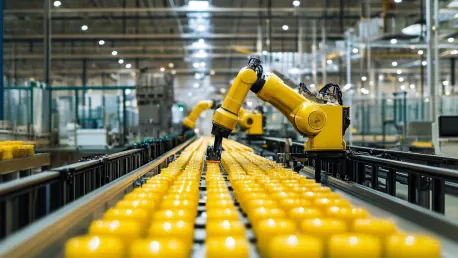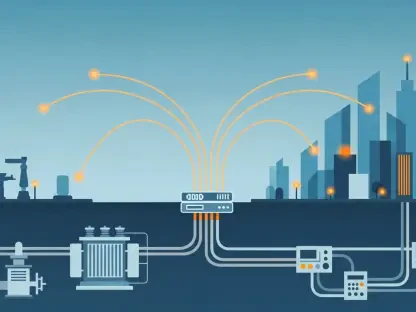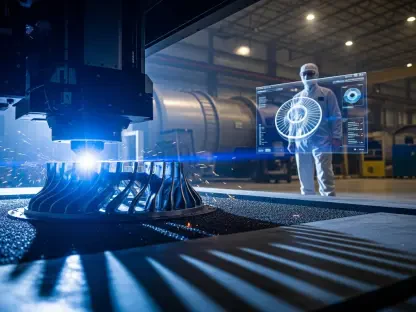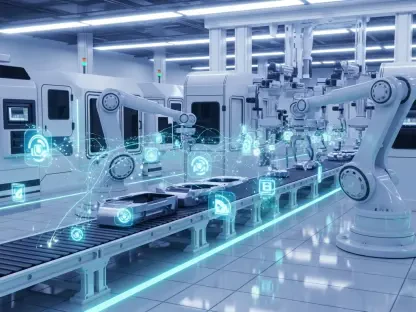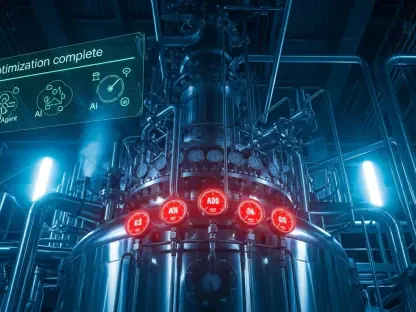The manufacturing and automation sectors are undergoing a monumental transformation driven by rapid technological advancements. From the integration of AI and robotics to the optimization of supply chains and the development of a skilled workforce, these changes are setting the stage for a more efficient, resilient, and sustainable future. This article delves into the key areas where technology is making a significant impact and explores the challenges and opportunities that lie ahead.
The Fifth Industrial Revolution in Automotive Manufacturing
Advanced Robotics in the UK Automotive Sector
The UK automotive industry is at the forefront of the fifth industrial revolution (5IR), characterized by the extensive use of advanced robotics. These robots are revolutionizing manufacturing processes by providing unprecedented precision and significantly enhancing productivity. The integration of robotics is not just about replacing human labor but augmenting it to achieve higher efficiency and quality. With advanced robotics, complex tasks that once required a significant amount of time and labor can now be completed more swiftly and accurately.
For instance, robots can perform intricate assembly tasks consistently without tiring and can work in hazardous environments where human presence would be risky. The deployment of robotics in the UK automotive sector is anticipated to lead to a considerable reduction in production errors, lower operational costs, and faster turnaround times. This trend is not isolated to the UK alone but is mirrored in automotive industries worldwide, as companies strive to stay competitive in a fast-evolving market. The robotics revolution is redefining manufacturing paradigms, pushing towards a future where human-robot collaboration is the norm, leading to enhanced overall productivity and innovation.
AIoT: The Convergence of AI and IoT
The convergence of Artificial Intelligence (AI) and the Internet of Things (IoT), known as AIoT, is playing a crucial role in the digital transformation of manufacturing. AIoT enables real-time monitoring, predictive maintenance, and overall improved operational efficiency. For instance, AI-aided predictive maintenance systems can foresee potential equipment failures with over 99% accuracy, allowing manufacturers to preempt costly downtimes and optimize maintenance schedules. This high level of accuracy in predicting maintenance needs helps in minimizing disruptions and extending equipment lifespans.
The integration of AIoT in manufacturing processes involves the deployment of smart sensors and interconnected devices that continuously collect data. This data is then analyzed by AI algorithms to detect patterns and predict issues before they arise. The widespread adoption of AIoT is significantly enhancing the ability of manufacturers to make informed decisions, streamline operations, and reduce waste. Moreover, the deployment of AIoT systems contributes to improved workplace safety by continuously monitoring conditions and providing early warnings of potential hazards. The ongoing evolution of AIoT promises further advancements in efficiency and innovation, solidifying its role as a pivotal component of modern manufacturing.
Supply Chain and Delivery Optimization
Challenges in CNC Manufacturing
In CNC manufacturing, the efficiency of supply chains is paramount. Accurate demand forecasting is essential to avoid pitfalls such as stock shortages or excess inventory, which can have severe financial repercussions. Streamlined and robust supply chains ensure that manufacturing processes are not disrupted and that products can be delivered swiftly to meet market demands. The complexity of CNC manufacturing processes necessitates precision in inventory management and logistics to maintain operational continuity.
The dynamic nature of the market can pose significant challenges for CNC manufacturers. Fluctuations in demand, raw material availability, and transportation issues can lead to bottlenecks that adversely affect production timelines. To address these challenges, manufacturers are increasingly leveraging digital supply chain solutions and advanced analytics. These tools provide real-time visibility into supply chain operations, enabling quick adjustments to mitigate risks. As the CNC manufacturing sector evolves, the ability to maintain an agile and efficient supply chain will be critical to sustaining competitiveness and profitability in a highly demanding industry.
Enhancing Supply Chain Resilience
Building resilient supply chains involves leveraging advanced technologies like AI and machine learning to improve demand forecasting and inventory management. These technologies help manufacturers respond swiftly to market changes and reduce the risk of supply chain disruptions. The focus is on creating agile and adaptable supply chains that can withstand various challenges, including geopolitical shifts and market volatility. By incorporating sophisticated predictive analytics, manufacturers can better anticipate market trends and adjust their supply chain strategies accordingly.
In addition to enhancing forecasting accuracy, the implementation of AI and machine learning in supply chain operations enables improved decision-making and resource allocation. Manufacturers are also exploring blockchain technology to enhance the transparency and traceability of their supply chains. Blockchain provides an immutable ledger of transactions, which can help in verifying the authenticity of products and preventing fraud. As global supply chains become more interconnected and complex, the need for resilience and adaptability will only grow. Investing in advanced technologies and innovative approaches to supply chain management will be essential for manufacturers to navigate the uncertainties of the modern global market effectively.
Talent Development and Workforce Challenges
Addressing the Labor Shortage
The US manufacturing sector is grappling with a critical labor shortage due to reshoring efforts, retirements, and the need for new skill sets. This has led to 65% of manufacturers identifying talent attraction and retention as their primary business challenge. Developing talent pipelines, providing continuous training, and creating attractive work environments are essential strategies to address this issue. To bridge the skills gap, companies are increasingly collaborating with educational institutions and industry associations to offer specialized training programs tailored to the needs of modern manufacturing.
Recruitment strategies are also evolving to attract a more diverse pool of candidates, including women and underrepresented minorities. Implementing mentorship programs, offering competitive compensation packages, and promoting career growth opportunities are some of the ways manufacturers are working to attract and retain skilled workers. Additionally, investment in automation and smart technologies can help alleviate some of the pressures caused by labor shortages by augmenting the existing workforce and improving overall productivity. However, the long-term solution lies in creating a robust and sustainable talent pipeline that can adapt to the ever-changing demands of the manufacturing sector.
The Importance of Upskilling
As technology evolves, the need for a skilled workforce capable of navigating these advancements becomes increasingly important. Upskilling and reskilling initiatives are crucial for ensuring that workers can effectively use new technologies and contribute to the sector’s growth. Manufacturers are investing in training programs and partnerships with educational institutions to build a future-ready workforce. These initiatives focus on equipping employees with the knowledge and skills needed to operate advanced machinery, leverage digital tools, and implement new manufacturing processes.
In addition to technical skills, there is a growing emphasis on developing soft skills such as problem-solving, critical thinking, and teamwork. These competencies are essential for fostering a culture of innovation and continuous improvement within the manufacturing industry. By prioritizing upskilling and reskilling, manufacturers can enhance employee engagement, reduce turnover, and create a more resilient and adaptable workforce. The ongoing commitment to workforce development will be vital for maintaining a competitive advantage in an increasingly technology-driven manufacturing landscape.
Impact of Geopolitical Changes
Navigating Trade Policy Shifts
Geopolitical factors, particularly in the United States, play a crucial role in shaping manufacturing strategies. Changes in trade policies, especially those related to China, could redefine global supply chains and necessitate a reevaluation of international partnerships. Businesses are advised to build resilience and agility into their strategies to better withstand the uncertainties brought about by these geopolitical shifts. The landscape of international trade is continuously evolving, and manufacturers must remain vigilant and proactive in their approach to managing external risks.
Manufacturers are increasingly diversifying their supplier base to reduce dependence on any single region and exploring new markets to expand their global footprint. Additionally, building strong relationships with local suppliers can mitigate the impact of international trade disruptions and enhance the overall stability of supply chains. By fostering strategic partnerships and maintaining a flexible approach, manufacturers can better navigate the complexities of global trade and ensure the continuity of their operations. The ability to adapt to changing geopolitical conditions will be a key factor in sustaining long-term growth and competitiveness in the global manufacturing industry.
Building Resilient Strategies
Manufacturers are focusing on creating resilient strategies that can adapt to changing geopolitical landscapes. This involves diversifying supply chains, exploring new markets, and investing in technologies that enhance operational flexibility. The goal is to ensure that manufacturing operations can continue smoothly despite external disruptions. By implementing robust risk management frameworks, manufacturers can identify potential vulnerabilities and develop contingency plans to address them proactively.
Investing in digital transformation initiatives, such as integrating AI and IoT technologies, can further enhance the resilience of manufacturing operations. These technologies provide real-time insights into supply chain performance, enabling manufacturers to make data-driven decisions and quickly respond to disruptions. Additionally, fostering a culture of innovation and continuous improvement within the organization can help manufacturers stay ahead of emerging trends and challenges. Creating a resilient manufacturing ecosystem requires a holistic approach that encompasses strategic planning, technological investment, and a commitment to agility and adaptability in the face of uncertainty.
Adoption of Smart and Sustainable Technologies
Smart Buildings and Sustainable Manufacturing
The adoption of smart buildings technologies offers a promising pathway for manufacturing industries to decarbonize operations. These technologies facilitate energy efficiency, reduce waste, and promote sustainable manufacturing practices, contributing to the broader goals of the circular economy. Smart buildings are equipped with sensors and automation systems that optimize energy use and enhance operational efficiency. By leveraging data analytics, manufacturers can monitor and control various aspects of their operations, from lighting and heating to equipment performance and resource consumption.
In addition to improving energy efficiency, smart buildings technologies can also enhance workplace safety and productivity. For example, automated systems can detect and respond to potential hazards, such as gas leaks or fire risks, in real time. By creating a safer and more efficient work environment, manufacturers can reduce operational costs and increase overall productivity. The integration of smart buildings technologies is a critical step towards achieving sustainability goals and ensuring the long-term viability of manufacturing operations. As environmental regulations become more stringent, the adoption of sustainable practices will be essential for maintaining compliance and meeting the expectations of consumers and stakeholders.
Scaling AI and Smart Technologies
AI and smart technologies are being scaled beyond pilots to enterprise-wide adoption, despite challenges posed by low digital maturity and strict regulations. These technologies are transforming manufacturing processes by enabling real-time data analysis, predictive maintenance, and enhanced decision-making. The focus is on leveraging these advancements to achieve higher efficiency and sustainability. By integrating AI and smart technologies across their operations, manufacturers can gain valuable insights into their processes and identify opportunities for optimization and innovation.
One of the primary benefits of scaling AI and smart technologies is the ability to enhance predictive maintenance capabilities. By analyzing data from equipment sensors, AI algorithms can predict when maintenance is needed, reducing downtime and extending the lifespan of machinery. Additionally, real-time data analysis enables manufacturers to identify and address potential issues before they escalate, improving overall operational efficiency. Despite the challenges of digital transformation, the long-term benefits of adopting AI and smart technologies far outweigh the initial investment. As these technologies continue to evolve, their impact on manufacturing efficiency and sustainability will only grow, driving continued innovation and growth in the sector.
Automation in Specific Industries
Food Industry: Embracing Automation
The food industry is increasingly adopting automation, particularly in palletizing, to maintain cleanliness and control in operations. Automation ensures that food manufacturing processes operate in clean and controlled environments, thereby enhancing safety and efficiency. The use of robotics in food processing helps in reducing human contact and contamination risks. Automated systems are capable of handling and packaging food products with precision, ensuring consistent quality and compliance with hygiene standards.
In addition to improving cleanliness and safety, automation in the food industry also enhances productivity and reduces labor costs. Robots can work continuously without breaks, handling large volumes of products with speed and accuracy. This increased efficiency enables food manufacturers to meet growing consumer demands and maintain a competitive edge in the market. As automation technologies continue to advance, their adoption in the food industry is expected to expand, driving further improvements in safety, efficiency, and overall production quality.
Warehouse Connectivity and Robotics
Warehouse operations are being transformed with the implementation of wireless mesh networks, which ensure seamless connectivity and support advanced warehouse robotics. This technological upgrade is crucial in future-proofing warehouses to handle the increasing demands of 24/7 operations. Wireless mesh networks enable real-time tracking and management of inventory, improving overall efficiency. By providing continuous and reliable connectivity, these networks support the deployment of sophisticated robotics that can handle various tasks, from picking and packing to inventory management and order fulfillment.
The integration of advanced robotics in warehouse operations reduces the need for manual labor and enhances the speed and accuracy of order processing. Robots equipped with AI and machine learning capabilities can navigate complex warehouse environments, optimizing routes and minimizing delays. Additionally, the use of automated guided vehicles (AGVs) and autonomous mobile robots (AMRs) streamlines material handling processes, increasing throughput and reducing operational costs. As e-commerce and consumer expectations continue to rise, the adoption of cutting-edge connectivity and robotics technologies will be essential for maintaining efficient and responsive warehouse operations.
Innovations and Networking at Trade Shows
Showcasing Innovations at PACK EXPO International
Trade shows like PACK EXPO International provide a platform for the manufacturing and automation industries to showcase cutting-edge technologies and innovations. These events are crucial for networking, sharing knowledge, and exploring new business opportunities. At PACK EXPO International, industry leaders and innovators gather to demonstrate advancements in areas such as AI, robotics, and supply chain optimization. The event highlights the transformative potential of these technologies and their role in driving the future of manufacturing and automation.
Showcasing innovations at trade shows not only helps manufacturers stay informed about the latest trends and developments but also fosters collaboration and partnerships. By engaging with peers and experts in the field, companies can gain insights into best practices, emerging technologies, and market opportunities. Trade shows serve as a catalyst for innovation, enabling manufacturers to explore new ideas, refine their strategies, and stay competitive in a rapidly evolving industry. As technological advancements continue to reshape manufacturing and automation, trade shows will remain a vital platform for driving progress and fostering industry growth.
